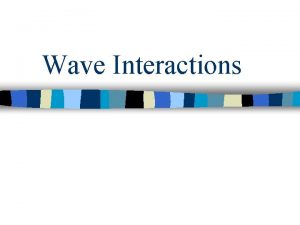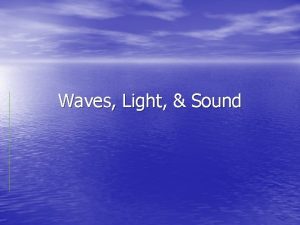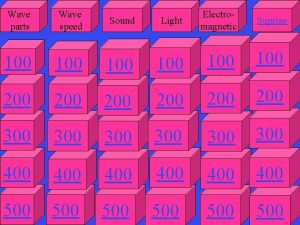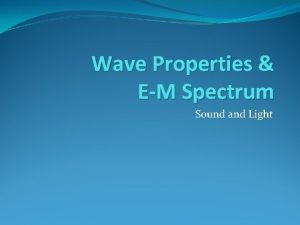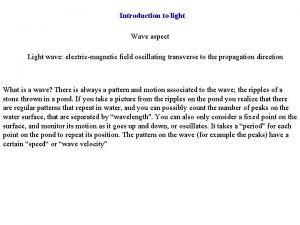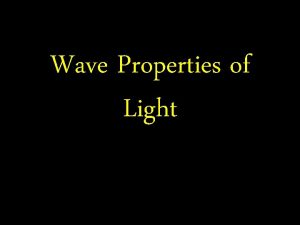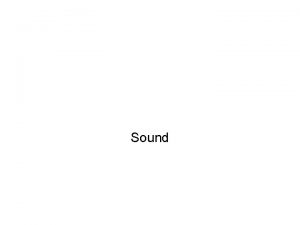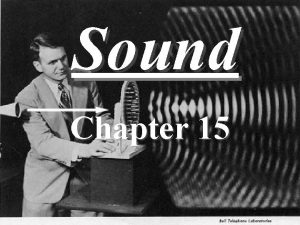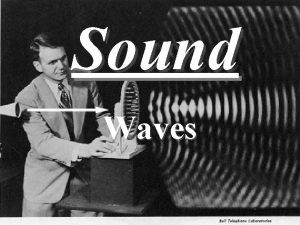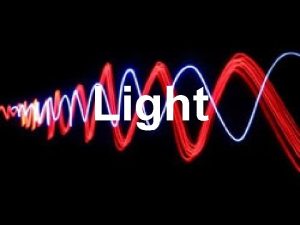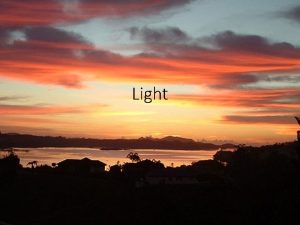Light vs Sound If sound is a wave















- Slides: 15

Light vs. Sound If sound is a “wave, ” what’s “waving? ”

Light vs. Sound • What makes a light wave different from a sound wave?

Light vs. Sound What makes a light wave different from a sound wave? • Light travels a lot faster than sound: Speed of light in air = 300, 000 meters per second Speed of sound in air (at 0 Celsius) = 331 meters per second At room temperature this increases to about 343 m/s.

Light vs. Sound What makes a light wave different from a sound wave? • Light can travel in empty space …Sound can’t because sound is the compression of the medium • For sound traveling in air, sound wave is made of variations in the pressure of the air

Air Pressure • Sound Wave = variation in pressure • Pressure = Force / Area • Air exerts a force (presses against surfaces) • Normally air pressure is not very noticeable because it tends to press on all side of a surface evenly • Air pressure is greatest at sea level (P = 1 atmosphere, or 1 atm)

Air Pressure: Examples • • Plastic bottle on airplane Using a straw Vacuum cleaner Vacuum Chamber experiments

Sound Wave • Loud Sound -> Big variation in air pressure • “Crest” of wave: region of high pressure • “Trough” of wave: Region of lower-thanusual pressure

Animation from Physics Classroom. com: http: //www. physicsclassroom. com Gray = atmospheric pressure Dark = high pressure Light = low pressure

Sound Waves Travel As Variations in Pressure

Transverse vs. Compression • Light is a transverse wave: Transverse means that the wave travels perpendicular to the displacement • Sound is a compression wave The wave travels in the same direction as the displacement • Waves on a slinky? • “The Wave” in a stadium? • Waves on a string?

Earthquakes • What’s the “medium” of an earthquake? • P-waves are compression waves • S-waves are transverse waves • Travel at different speeds

“Seeing” Sound Waves A microphone converts pressure waves to electrical signals. An oscilloscope takes an electrical signal as “input” and displays a graph of the signal as a function of time • Do you think an oscilloscope could be used to measure frequency, wavelength, or both?

The Octave = 8 notes apart Going an “octave” higher means doubling the frequency of a note Going an octave lower means halving the frequency of a note Octave demo with oscilloscope: http: //www. animations. physics. unsw. edu. au/jw/sound-pitch-loudness-timbre. htm

Perception of Sound Waves Ph. ET Simulation: “Sound”

Review • What determines how fast a wave travels? • Can you make a wave go faster by putting more energy into the wave? • What, physically, is sound? • Give examples of longitudinal waves and transverse waves.
 Light light light chapter 22
Light light light chapter 22 Light light light chapter 23
Light light light chapter 23 Light light light chapter 22
Light light light chapter 22 P and s wave chart
P and s wave chart Odd quarter wave symmetry
Odd quarter wave symmetry Transverse and longitudinal waves both *
Transverse and longitudinal waves both * Full wave rectified sine wave fourier series
Full wave rectified sine wave fourier series Sound is a transverse wave true or false
Sound is a transverse wave true or false Examples of mechanical waves
Examples of mechanical waves Venn diagram of mechanical and electromagnetic waves
Venn diagram of mechanical and electromagnetic waves Examples of half wave rectifier
Examples of half wave rectifier What is a repeating disturbance
What is a repeating disturbance Long waves and short waves
Long waves and short waves Velocity frequency wavelength triangle
Velocity frequency wavelength triangle Full wave rectifier vs half wave rectifier
Full wave rectifier vs half wave rectifier The nature of waves chapter 10 section 1
The nature of waves chapter 10 section 1

















